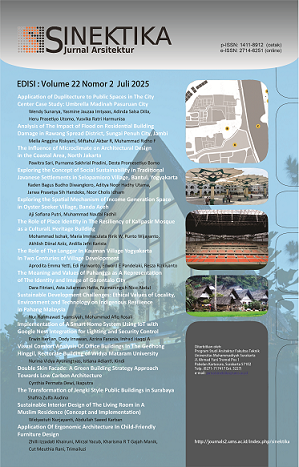The Meaning and Values of Pahangga as a Representation of The Identity and Image of Gorontalo City
DOI:
https://doi.org/10.23917/sinektika.v22i2.8958Keywords:
City Identity, City Image, Gorontalo, PahanggaAbstract
Gorontalo, a city rich in history and culture, has many elements of traditional architecture that serve as symbols of the identity and cultural heritage of its people. One important element in Gorontalo's traditional architecture is the Pahangga. Although previous research has discussed Gorontalo’s traditional architecture, limited studies have explored how Pahangga can be adapted in contemporary architecture while preserving its symbolic meaning. This study aims to explore the meaning and value of Pahangga as a representation of the identity and image of Gorontalo City. Pahangga, which is an ornament of Gorontalo culture, has a deep history and meaning in local culture. The method used is a descriptive qualitative approach with a semiotic approach, which analyzes signs and symbols to explore the philosophical meaning and cultural values contained in the Pahangga elements. The results of the study show that Pahangga has been used as a decorative element in various public buildings, such as school gates, city parks, and boundary gates. Pahangga not only has a symbolic meaning related to social hierarchy and cultural values, but also plays a role in shaping the identity and visual image of the city. This study concludes that Pahangga has great potential to be strengthened as an element that forms the identity and image of Gorontalo City through wider application to urban elements such as pedestrian paths and landmarks. Thus, the contributions and practical implications are expected to be a guide for city planners such as architects, urban planners, and parties involved in adopting local cultural elements as part of efforts to create inclusive, iconic, and culturally meaningful public spaces amidst city modernization.
Downloads
References
Akili, R. (2012). Ornamen pada Pelaminan Tradisional Kota Gorontalo (tinjauan Bentuk dan Makna). Skripsi. Gorontalo: Program Sarjana Universitas Negeri Gorontalo.
Al-Kodmany, K. (2001). Supporting imageability on the World Wide Web: Lynch’s five elements of the city in community planning. Environment and Planning B: Planning and Design, 28(6), 805–832.
Aswin, U. R., & Hidayat, D. (2019). Analisis Pengaruh Citra Merek, Persepsi Harga, Sikap Merek, Lokasi dan Word of Mouth Terhadap Niat Menonton di Cinema XXI Kota Padang. AMAR (Andalas Management Review), 3(1), 115–132.
Eco, U. (1976). A Theory of Semiotics. Indiana University Press.
Eka, R., & Imran, M. (2022). Makna Filosofis Rumah Adat Gorontalo (Dulohupa Dan Bantayo Pobo’ide). Jurnal Peradaban Sains, Rekayasa, Dan Teknologi, 10(1), 95–105.
Hayden, D. (1997). The Power of Place: Urban Landscapes as Public History. MIT Press.
Heryati, H., & Abdul, N. N. (2014). Kearifan Lokal pada Arsitektur Vernakular Gorontalo: Tinjauan Pada Aspek Budaya dan Nilai-nilai Islam. El Harakah: Jurnal Budaya Islam, 16(2), 151–173.
Lynch, K. (1960). The image of the city/Lynch Kevin. Cambridge [Mass.] Technology Press,.
Muhammad, A., Baruadi, M. K., Fatsah, H., & Djou, D. N. (2023). Makna Simbolik Istilah Konstruksi Bangunan Adat Bantayo Poboide Gorontalo. Aksara: Jurnal Ilmu Pendidikan Nonformal, 9(1), 355–372.
Norberg-Schulz, C. (1980). Genius Loci: Towards a Phenomenology of Architecture. Rizzoli International Publications.
Rapoport, A. (1982). The Meaning of the Built Environment: A Nonverbal Communication Approach. Sage Publications.
Sari, T. Y., Kurnia, H., Khasanah, I. L., & Ningtyas, D. N. (2022). Membangun identitas lokal dalam era globalisasi untuk melestarikan budaya dan tradisi yang terancam punah. Academy of Social Science and Global Citizenship Journal, 2(2), 76–84.
Sudana, I. W. (2022). Fungsi Seni Karawo dalam Kehidupan Sosial Budaya Masyarakat Gorontalo. Jurnal Ideas: Pendidikan Sosial Dan Budaya, 8, 1071–1078. https://doi.org/10.32884/ideas.v8i2.797
Sudana, I. W., Suparno, T. S., & Dharsono, G. (2018). Aesthetic Values of Ornaments in Karawo Textile in Gorontalo. Arts and Design Studies, 68, 1–9.
Suryani, A. C. (2020). TA: Nilai-Nilai Budaya Lokal Sunda Dalam Identitas Kawasan Perkotaan Purwakarta. Institut Teknologi Nasional Bandung.
Downloads
Submitted
Accepted
Published
Issue
Section
License
Copyright (c) 2025 Sinektika: Jurnal Arsitektur

This work is licensed under a Creative Commons Attribution-NonCommercial 4.0 International License.











